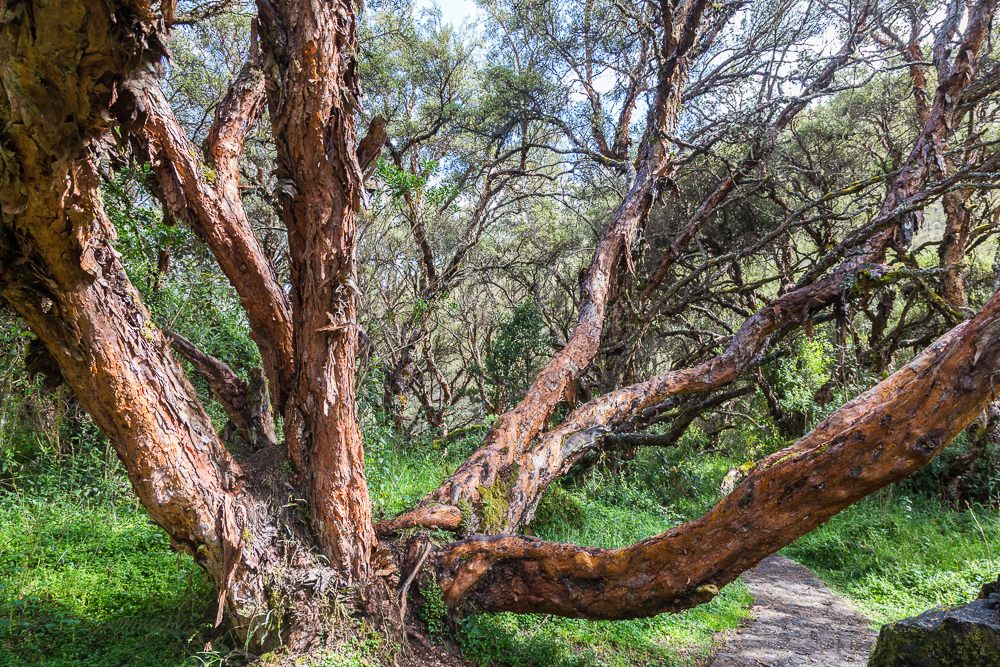These Fairytale Trees Only Grow at Incredible Altitudes
 Polylepis tree limbs intertwine overhead in the forest around Polylepis Lodge in Ecuador. (All photos: Eric Mohl)
Polylepis tree limbs intertwine overhead in the forest around Polylepis Lodge in Ecuador. (All photos: Eric Mohl)
What has red, peeling skin and is found only in the Andes? Polylepis trees, some of the oddest and rarest trees on the planet. This genus thrives only in the cold mist and thin air of the Andes Mountains, and one of the rarest types of Polylepis can be seen only in northern Ecuador.
The name Polylepis (which is pronounced pah-lee-LEH-piss) comes from the Greek words for many (poly) and layers (letis). It’s a fitting moniker, since the bark of the Polylepis is composed of thin, deep red layer that collectively make up a skin hearty enough to stand up to a cold, wet, and windy environment. These layers peel naturally in paper-like sheets, inspiring the easier-to-pronounce nickname “paper tree.”
 There are more than 20 different types of Polylepis trees and shrubs and all of them have a gnarled, wind-swept, otherworldly look.
There are more than 20 different types of Polylepis trees and shrubs and all of them have a gnarled, wind-swept, otherworldly look.
There are more than 20 species of shrubs and trees in the Polylepis genus, which is part of the rose family, and all of them are exclusively found in the Andes from northern Venezuela to Northern Chile and Argentina. They grow at elevations up to 16,400 feet, which makes Polylepis one of the highest naturally occurring genuses of tree in the world.
They’re also one of the slowest-growing trees in the world; some take more than 100 years to growing half an inch in diameter. They grow faster at milder, lower elevations, where the trees can reach heights approaching 150 feet. Scientists speculate that vast areas of the Andes were once covered in Polylepis trees, but over time they were cut to clear the way for grazing animals and to provide firewood and building materials for the area’s indigenous populations, including the Incas.
 It may have taken this massive Polylepis tree decades to reach this size.
It may have taken this massive Polylepis tree decades to reach this size.
The loss of Polylepis forests can result in reduced wildlife habitat and increased soil erosion from wind and rain. The remaining Polylepis forests in Southern Peru and Bolivia, for example, are the only place on earth where critically endangered Royal Cinclodes birds are found, and this fact has helped spark a Polylepis forest conservation effort there.
In Ecuador, Polylepis forests are protected in a number of ways. International nonprofit Fundación Ñucanchi Yuracuna aims to purchase 400 acres of land in Ecuador in order to reforest it with native Polylepis species. Polylepis forests are also protected within Ecuador’s 4,000-acre El Angel Reserve, which is free to enter since the Ecuadoran president waived all entrance fees to national parks and reserves (except Galapagos Islands National Park) in 2012.
 The peeling, twisted limbs of Polylepis trees reach out over a high altitude lake in the private reserve that surrounds Polylepis Lodge in Ecuador.
The peeling, twisted limbs of Polylepis trees reach out over a high altitude lake in the private reserve that surrounds Polylepis Lodge in Ecuador.
To see even rarer Polylepis trees, visit the private reserve adjacent to El Angel, about three hours from Quito. In 2000, concerned about unchecked deforestation, hotel manager Juan Fernando Acosta cooperated with a group of local inhabitants to purchase 80 acres of land —most of it in a valley 12,000 feet above sea level—as a protected space for trees.
Nearly 50 acres of the reserve are forested with Polylepis Incana trees, one of the rarest species of Polylepis on the planet. This is the largest forest of this particular species of Polylepis on the planet. To encourage as many people as possible to experience this weird and wonderful tree, Acosta built the Polylepis Lodge within the reserve and established trails through part of this unique forest.
 Paths and small bridges lead visitors through one of the rarest stands of Polylepis trees on earth at Polylepis Lodge in Ecuador.
Paths and small bridges lead visitors through one of the rarest stands of Polylepis trees on earth at Polylepis Lodge in Ecuador.
Some of the Polylepis Incana trees on the reserve are 6.5 feet wide. At their snail’s-pace growth rate, that means these trees are thousands of years old. And they look it. Bent and twisted, they hunker down as if braced against the ravages of their environment and time itself. Trails meander through the trees, crossing small streams and circling high altitude lakes through an ancient, endangered world that seems built for hobbits, not humans.
It’s a fittingly magical place to encounter trees found nowhere else on earth.














Follow us on Twitter to get the latest on the world's hidden wonders.
Like us on Facebook to get the latest on the world's hidden wonders.
Follow us on Twitter Like us on Facebook